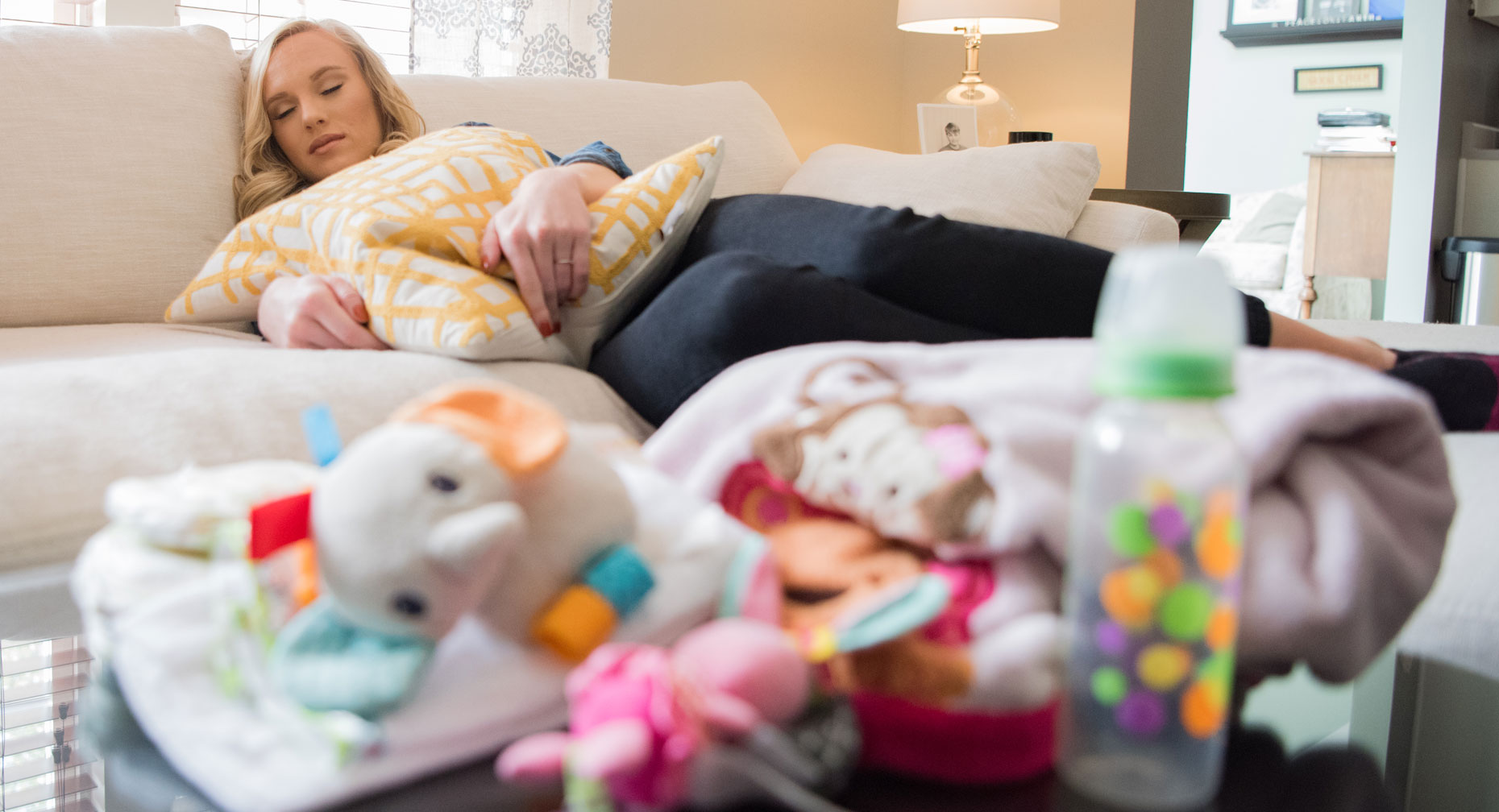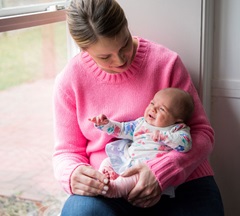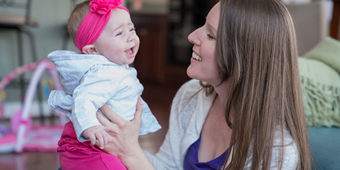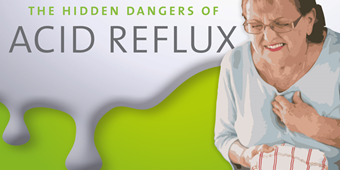Oh Baby, What Have You Done to Mom’s Body?

Answer a few questions and we'll provide you with a list of primary care providers that best fit your needs.
Over nine months of pregnancy, you have time to adjust to the very obvious changes in your body. Giving birth ushers in a different set of physical and emotional changes, especially in the first six weeks after baby’s arrival.
Some of these effects, like perineum soreness, go away with time. Others, such as stretch marks, can linger.
Certified nurse midwife Melissa Burkhardt, CNM, MSN, with Women’s Health Specialists & Midwives of Dayton knows the challenges of postpartum recovery. As a midwife, she strives to ensure moms-to-be have realistic expectations for the weeks following birth.
“In other cultures women aren’t expected to be productive, like cleaning the house, but in our culture many women are expected to jump right back into old routines,” she says. The media’s portrayal of energetic moms and squeaky clean newborns immediately after birth are unrealistic and not helpful to a new mom who is struggling, she adds.
It may help you to embrace these transformations as a sign of your motherhood, knowing there are time-tested methods to minimize their impact and get your body back to pre-baby form. And fortunately, many of these tactics, such as a healthy diet and a warm soak in the bath, help to solve multiple issues.
Recovery After Delivery
You’ve heard it before, but Kegel exercises do help. Doing them before giving birth strengthens your muscles and can help speed your recovery from a vaginal birth.
Many women experience several body changes immediately after giving birth.
Numbness. If you had anesthesia, your lower body and legs will be numb after your baby is born. Your doctor and nurse will monitor you as the anesthesia wears off. They will help you begin to move around.
C-section pain. If you deliver your baby by Cesarean section, you may feel pain and tenderness at the incision site. You may also feel very tired. Your doctor and nurse will provide pain medicine and will monitor the dressings on your incision.
Shaking and chills. If you have a vaginal delivery, your body needs to recover from the exertion. Shaking and chills last for a short time. Your doctor will check your temperature and blood pressure and monitor them until you are stable.
Perineum pain and soreness. The perineum stretches and may tear during a vaginal birth. You may have an episiotomy — your doctor cuts the perineum — to make more room for the baby. To feel better you can:
- Use an ice pack wrapped in a towel.
- Sit on a pillow.
- Soak in a warm bath.
- Wipe from front to back to prevent infection.
- Ask your doctor for medicine to ease the pain.
- Do Kegel exercises to rebuild strength.
After-birth pains. Your uterus grew tremendously during your pregnancy, becoming round and hard and weighing about 2 ½ pounds. To return to its normal size, the uterus cramps as it shrinks back down to a small 2 ounces. Cramps should go away in a few days.
Vaginal discharge (lochia). After you give birth, your body releases the uterine lining, including blood and tissue. You will need to use a sanitary pad, as the flow can be heavy for a few days. The discharge may continue for a few weeks or a month.
7 Post-Pregnancy Symptoms
As you get to know your new baby, you’ll also need to manage being a new mom and rebuild your strength after giving birth. Although typically not covered by insurance, Burkhardt recommends moms enlist the help of a doula who provides guidance and support to moms during and after birth.
If you are breastfeeding, Burkhardt recommends seeking assistance from lactation consultants who will coach you, typically at no charge. As you breastfeed, new changes will appear within a day or two. While you may be uncomfortable at first, remember that breastfeeding provides many benefits to your baby — and to you, including:
- Burning calories to help you to maintain a healthy weight
- Promoting uterine contractions, which decreases bleeding and helps your uterus return to normal size faster
You will notice differences in your body and body systems as your hormones and weight return to a non-pregnant state. Common signs include:
1) Breast engorgement. When your milk comes in, your breasts may feel very full, warm and even painful. Feeding your baby helps to relieve these symptoms. If you are not breastfeeding, or if your enlarged breasts are very uncomfortable, try these tips:
- Take a warm shower.
- Place warm towels on your breasts.
- Talk with your doctor.
If you are not breastfeeding, wear a sports bra or other supportive bra.
2) Nipple pain. Breastfeeding, especially for the first time, can lead to painful and sore nipples. Creams are available to help. Ask your doctor which one is best for you. Letting your breasts air dry also helps to retain moisture.
3) Swelling. Your body made lots of extra fluids to get you ready to give birth. It may take some time for swelling to go away after your baby is born. To manage swelling in your legs and feet you can:
- Lie on your left side.
- Put your feet up when sitting.
- Try to stay cool.
- Wear loose clothes.
4) Sweating. Your body is also overloaded with pregnancy hormones. As hormone levels return to normal, you may find yourself sweating, especially at night. To reduce sweating and stay cool you can:
- Sleep in a towel to keep your sheets and pillow dry.
- Use light blankets.
- Wear light cotton pajamas to bed.
5) Hemorrhoids. Many women develop painful, swollen veins around the anus during pregnancy or during delivery. Hemorrhoids sometimes get worse after your baby is born, and for many women they do get better over time. To ease their discomfort you can:
- Soak in a warm bath.
- Ask your doctor which over-the-counter spray or cream is best to relieve your pain.
- Eat foods that are high in fiber, such as fruits, vegetables and whole-grain breads and cereals.
- Drink lots of water.
- Avoid straining during a bowel movement.
6) Constipation. Hormone and other body changes can sometimes lead to constipation after your baby is born. Constipation can also aggravate hemorrhoids. Try these to help your body adjust:
- Eat foods high in fiber, like fresh fruits and vegetables.
- Drink plenty of water.
- Take a stool softener.
- Talk with your doctor about medicines that can help.
7) Urinary problems. Giving birth vaginally can cause problems with urination. You might experience pain, burning or incontinence. To ease symptoms:
- Drink lots of water.
- Soak in a warm bath.
- Run water in the sink when you go to the bathroom.
- If the pain continues, talk to your doctor.
- Do Kegel exercises to strengthen your pelvic muscles.
Caring for Your Postpartum Body
As your body returns to normal in the first few weeks after giving birth, you may notice that some conditions seem to linger, such as:
- Feeling tired all the time (fatigue)
- Stretch marks on your skin
- Hair loss
- Extra weight
You can rest easy knowing that all of these symptoms are normal for new moms, and things generally do get better.
Being tired. You feel tired because you lost a lot of blood during labor and delivery and your baby probably is not sleeping for long spells. To fight the fatigue, you can:
- Sleep when your baby sleeps, even during the day.
- Eat healthy foods, such as fruits, vegetables, whole-grain breads and pasta, lean meat and chicken.
- Limit sweets and fatty foods.
- Ask family and friends for help with the baby and around the house.
Stretch marks. When you are pregnant, your skin may stretch on your belly, bottom, breasts and thighs. You can use creams to minimize the look of these marks.
Hair loss. Pregnancy hormones often bring thicker, fuller hair. As your body returns to normal, your hair will thin out and may even fall out. Hair loss usually stops three to four months after your baby is born. To reduce the amount of hair you lose:
- Eat lots of fruits and vegetables to help your hair grow.
- Be gentle with your hair; avoid tight ponytails or braids.
- Use the cool setting on your hair dryer.
Extra weight. Most moms gain weight during their pregnancies. Getting rid of the extra pounds can sometimes take longer than you might like.
Talk with your doctor about a healthy target weight for you and when you can start getting more active.
It will take time for your body and your belly to get back into shape, but you can help yourself to get fit faster, such as:
- Eat healthy foods. Limit sweets and foods with a lot of fat.
- Drink lots of water.
- Do something active every day.
- Breastfeed your baby.
- Breastfeeding helps you burn calories.
- This can help you lose the weight faster than if you weren’t breastfeeding.
If you plan to have more children, it is best to be at a healthy weight before you get pregnant again.
Embrace these transformations as a sign of your motherhood, knowing there are time-tested methods to minimize their impact.
Thyroiditis: Unbalanced Metabolism
During the first year after giving birth, some women develop thyroid problems. It is unclear what causes the condition, but the thyroid becomes inflamed and no longer functions properly.
Known as postpartum thyroiditis the condition often starts with an overactive thyroid, lasting two to four months.
Then women develop underactive thyroid, which can last a year. Symptoms include:
- Fatigue
- Sleep problems
- Low energy
- Changes in weight
Because these symptoms are common after having a baby, thyroiditis can go undiagnosed. Talk with your doctor f you have symptoms that do not go away.
For most women, thyroid function returns to normal as the thyroid heals with help from medicines to reduce the inflammation.
An underactive thyroid needs to be treated. Some women may develop permanent underactive thyroid disease, called Hashimoto's disease. This requires lifelong treatment.
Healing Takes Time
“After having a baby, some moms transition back more slowly,” says Burkhardt. You may need support from family and friends, and to understand that it takes time to heal. At the earliest, new moms may start to feel better after two weeks. But prolonged labor or extensive tearing can take six to 12 weeks to heal. And emotionally it can take up to a year, she explains.
Ready for Baby No. 2?
Remember that if you are not breastfeeding, your period could return six to eight weeks after your baby is born.
If you are breastfeeding, it may be several months before your menstruate.
The optimal time to attempt to get pregnant again is 18 months after your last baby was born. If you are not ready to become pregnant again, talk with your doctor.
- Your body may ovulate before your period restarts, which means you can get pregnant whether or not you are breastfeeding.
- Birth control can help.
- Ask your doctor which birth control is safe to use if you are breastfeeding.
Answer a few questions and we'll provide you with a list of primary care providers that best fit your needs.
Source: MarchofDimes.org; Womenshealth.gov; Melissa Burkhardt, CNM, Women’s Health Specialists & Midwives of Dayton; Doulas and Support During Childbirth, Healthwise, May 29, 2019





